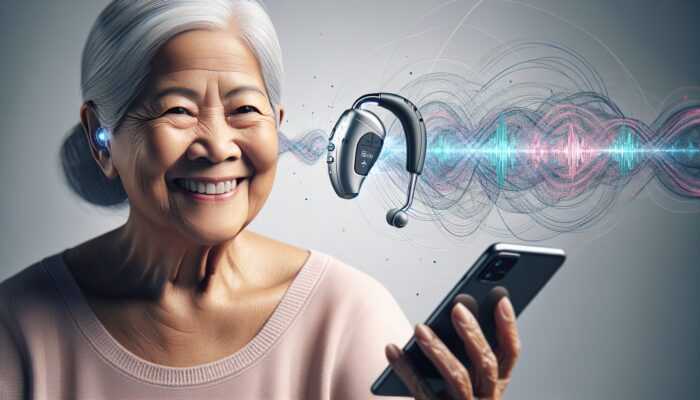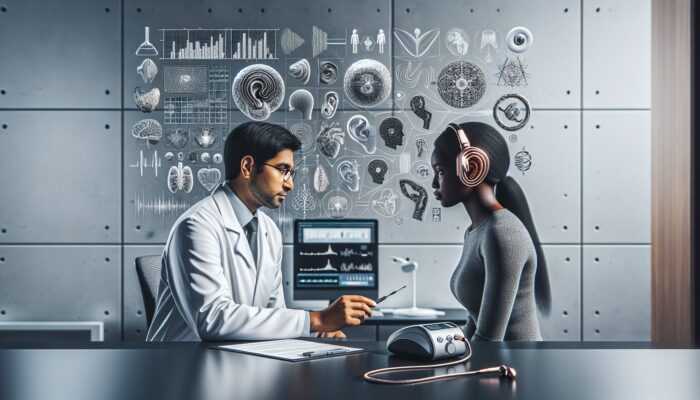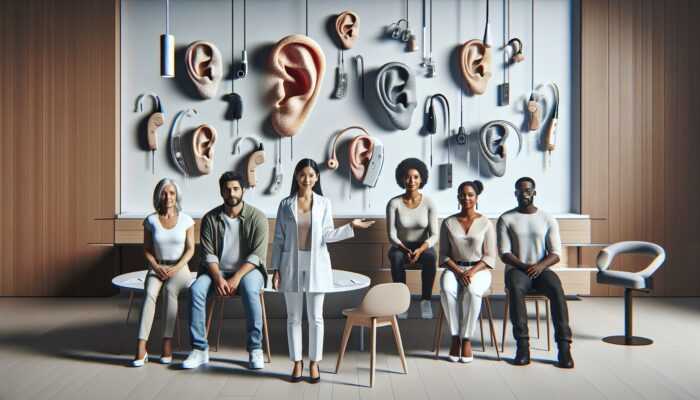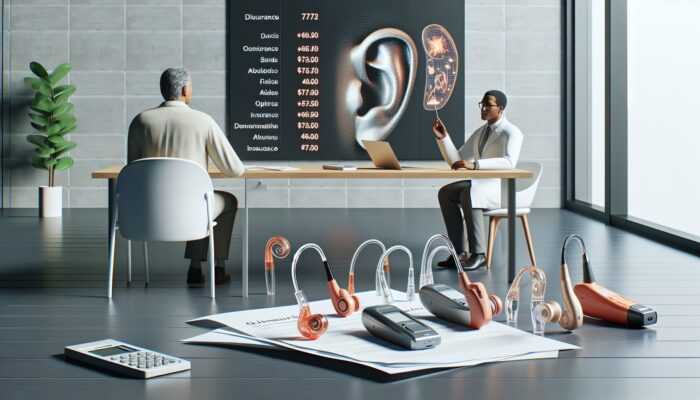Transforming Hearing Aids with Cloud Connectivity
Enhancing Wireless Connectivity for Better Hearing

The revolutionary impact of cloud technology in hearing aids is evident in their ability to connect wirelessly to the cloud. This seamless integration facilitates robust data transfer and enables audiologists to perform remote adjustments, fundamentally transforming the user experience. Devices can communicate in real time, allowing audiologists to make immediate changes to hearing aid settings. For instance, a resident in Sydney may realize that their hearing aids are not aligned with their preferences after relocating. A quick wireless connection to the cloud allows an audiologist based in London to adjust the settings on the spot, ensuring optimal performance despite the geographical distance.
The implications of this technology extend far beyond mere convenience. Wireless integration enhances communication between hearing aids and a variety of devices, allowing users to stream music, phone calls, and other audio directly. Whether navigating a bustling market in Thailand or enjoying a peaceful day in a park in Switzerland, users can experience a customized auditory environment, effortlessly adapting to the surrounding sounds. Additionally, this wireless technology reduces the need for physical adjustments, promoting user independence and significantly enhancing the overall hearing experience for individuals across the globe.
Seamless Data Synchronization Across Devices
The efficiency of cloud technology in hearing aids is greatly enhanced by the feature of data synchronization. This functionality ensures that hearing aid settings are automatically synchronized across multiple devices, creating a cohesive user experience. Whether a user transitions from a smartphone to a tablet, the change occurs smoothly and without disruption. Consider a traveler in Brazil who utilizes both a smartphone and a tablet; with synchronized settings, switching devices becomes effortless, as there’s no need to manually adjust the hearing aids—everything remains consistent, ensuring peace of mind.
Data synchronization also plays a pivotal role in crafting a more personalized hearing experience. Users can modify settings on one device, and those alterations automatically reflect across all connected devices in real time. This level of integration is critical for maintaining optimal performance, particularly in diverse auditory environments. For individuals with specific auditory requirements, such as those living in urban versus rural settings, having synchronized settings guarantees that they are always prepared for their surroundings, ultimately enhancing overall satisfaction and usability.
Instantaneous Real-Time Updates for Enhanced Performance
The capability of delivering real-time updates exemplifies the transformative power of cloud technology in modern hearing aids. Users benefit from automatic firmware and software updates, improving the functionality and longevity of their devices without necessitating physical visits to an audiologist. For example, a user in New Delhi may receive an immediate update that enhances their hearing aid’s noise-cancellation feature, allowing them to enjoy clearer sound even amidst the chaos of crowded festivals or busy streets.
These real-time updates also empower manufacturers to respond swiftly to user feedback and emerging technologies. By leveraging cloud technology, companies can implement enhancements based on analytics of user behavior and preferences. This agile responsiveness is crucial in a rapidly evolving technological landscape, ensuring that hearing aids remain effective as they adapt and improve. With continuous enhancements delivered directly to their devices, users are encouraged to embrace new features that significantly elevate their quality of life, fulfilling the connectivity demands of today’s modern users.
Comprehensive Data Storage and Management Solutions

Robust and Secure Cloud Storage for User Data
At the core of cloud technology in hearing aids lies the assurance of secure cloud storage. The sensitive information collected by hearing aids—including user preferences, usage statistics, and audiological data—is stored securely to safeguard user privacy and data integrity. This level of security is crucial, as users may be apprehensive about sharing personal details without a guarantee of safety. Advanced encryption techniques and strict access controls ensure that only authorized personnel can access this information, fostering a strong sense of trust between users and manufacturers.
The implications of secure cloud storage extend beyond privacy concerns; they also significantly enhance user experience. For instance, a user in Cape Town can feel assured that their hearing aid data is protected, allowing them to explore various features without fear of unauthorized exposure. Furthermore, manufacturers can utilize aggregated data—anonymized and secure—to improve product offerings and tailor services to meet the diverse needs of users across different cultures and regions.
Convenient Data Accessibility for Users
The accessibility of data is another essential component of cloud technology in hearing aids. Users can effortlessly access their hearing aid data from any internet-connected device, providing greater convenience and control over their auditory experience. Picture a person in Tokyo checking their hearing aid performance data through an app on their laptop while savoring a cup of tea; this ease of access empowers users to make informed adjustments to their settings based on real-time feedback.
Moreover, data accessibility supports informed decision-making. Users can analyze their hearing patterns and preferences, leading to more personalized settings tailored to their unique auditory experiences. This global perspective is vital for users across different geographic locations, as varying environments significantly influence auditory needs. For instance, a user in the tranquil countryside of New Zealand may require different settings compared to someone navigating the vibrant streets of New York City, illustrating the importance of personalized adjustments for optimal hearing.
Leveraging Data Analytics for Enhanced User Experience

Cloud-based analytics play a crucial role in transforming the experiences of hearing aid users. By harnessing the vast amounts of data collected, manufacturers can gain valuable insights into users’ hearing aid usage patterns. This information can inform personalized adjustments and enhance the overall functionality of hearing aids. For example, a user in Mexico City might notice their device struggles in noisy environments; data analytics can identify these patterns, allowing audiologists to fine-tune settings accordingly, thus ensuring users have the best possible experience in any auditory setting.
Additionally, data analytics can illuminate trends that benefit the entire community of users. By understanding common challenges faced by users in various regions—such as difficulties with wind noise in rural areas or challenges encountered in crowded public transportation—manufacturers can proactively develop solutions. This global approach to problem-solving ensures that advancements in hearing aid technology are rooted in real-world usage, leading to devices that truly meet the diverse needs of users worldwide.
Remote Adjustments and Ongoing Support for Users
Telehealth Services Revolutionizing Audiology
The integration of telehealth services into cloud technology in hearing aids signifies a major advancement in user support. Audiologists can now remotely adjust hearing aids, providing essential assistance without the need for in-person visits. This capability is invaluable for users in remote areas or those facing mobility challenges. Imagine an elderly individual residing in a small town in Canada receiving timely adjustments from an audiologist located halfway across the globe. This accessibility not only promotes better hearing outcomes but also fosters a sense of connection between users and healthcare professionals.
Telehealth also streamlines the process of obtaining support and troubleshooting. Users can quickly report issues and receive immediate feedback on necessary adjustments for their devices. This dynamic interaction enhances satisfaction and can lead to quicker resolutions of problems, reflecting a shift towards a more patient-centered model in audiology. The ease of accessing expert advice from anywhere in the world is a game-changer for users, empowering them to take charge of their hearing health.
Incorporating User Feedback for Continuous Improvement
Incorporating user feedback into the development and adjustment of hearing aids exemplifies the collaborative nature of cloud technology in hearing aids. Cloud platforms facilitate effortless communication between users and audiologists, allowing for quick reporting of issues and suggestions for improvements. A user in Buenos Aires, for example, can share their experiences with a specific feature, prompting manufacturers to consider enhancements or modifications that better align with user needs and expectations.
This feedback loop is essential for ongoing improvement, as it allows manufacturers to adapt quickly to user preferences and market demands, driving innovation in design and functionality. Furthermore, users feel valued when their feedback is acknowledged and acted upon, fostering a positive relationship between consumers and manufacturers. By nurturing this two-way communication, hearing aids can evolve in ways that genuinely reflect the needs and desires of users worldwide.
Convenient Scheduled Maintenance for Optimal Performance
The capability to schedule maintenance through cloud technology in hearing aids introduces a new level of convenience for users. With cloud connectivity, audiologists can organize routine check-ups and updates without the need for physical visits. This not only saves time but ensures that users’ devices are consistently optimized for performance. For instance, a busy professional in Berlin can schedule a remote maintenance check during their lunch break, ensuring their devices remain in excellent condition without disrupting their daily routine.
This proactive approach to maintenance is critical for maintaining optimal hearing aid functionality. Regular checks can preemptively address potential issues, minimizing downtime and ensuring that users enjoy a seamless auditory experience. The global reach of cloud technology means that users in diverse environments—from the vibrant streets of São Paulo to the tranquil landscapes of Norway—can benefit from the same level of service and support, reinforcing the universal appeal of modern hearing aids.
Personalization and Customization for Enhanced User Experience
Creating Tailored User Profiles for Unique Experiences
The emergence of user profiles in hearing aids illustrates an impressive application of cloud technology in enhancing personalization. By enabling the creation of tailored user profiles, hearing aids can adapt to individual preferences and lifestyles, ensuring optimal auditory experiences. For instance, a student in a university setting may require different settings during lectures compared to casual social gatherings. This flexibility in user profiles allows for quick transitions, seamlessly accommodating varying acoustic environments.
This personalized approach extends beyond simple adjustments. User profiles can store preferences for different environments, such as quiet rooms, crowded venues, or outdoor settings. This adaptability empowers users worldwide, from urban dwellers in Tokyo to rural residents in Australia, allowing them to experience the best possible hearing in any situation. The cloud’s capability to store and synchronize these profiles means that users can switch devices or locations without sacrificing audio quality or personal preferences.
Utilizing Adaptive Learning for Enhanced Hearing Aid Functionality
Adaptive learning is a significant factor in the overall effectiveness of cloud technology in hearing aids. Many modern hearing aids incorporate algorithms that analyze usage patterns over time, allowing them to adjust automatically to user preferences and environmental changes. For example, a user in Paris may notice their device gradually becomes more adept at filtering out background chatter in cafés, thanks to its learning capabilities. This intelligent adaptation creates a more intuitive user experience, as the device learns and evolves alongside the individual’s needs.
The implications of adaptive learning are profound. Users benefit from devices that can tailor sound settings based on their unique listening habits, reducing the necessity for constant manual adjustments. This feature not only increases satisfaction but also encourages users to engage more actively with their hearing aids, fostering a deeper understanding of their auditory environment. As technology continues to advance, adaptive learning will play an increasingly vital role in creating personalized auditory experiences that cater to individuals around the globe.
Designing Custom Soundscapes for Unique Listening Experiences
The ability to create and store custom soundscapes represents a new frontier in the personalization of hearing aids through cloud technology. Users can design unique auditory environments that cater to specific activities or settings, greatly enhancing their overall listening experience. Whether it’s a calming soundscape for meditation or an immersive environment for enjoying music, these customizations enable a level of personalization that was previously unattainable.
For instance, a user in Los Angeles might design a soundscape that incorporates the sounds of ocean waves while blocking out urban noise. This tailored auditory experience can transform everyday activities, making them more enjoyable and engaging. The cloud’s ability to store these custom soundscapes ensures that users can access them from any connected device, promoting a seamless integration of technology into daily life. As users around the world explore diverse auditory landscapes, the potential for creativity and expression in sound becomes virtually limitless.
Integration with Other Devices for Enhanced Functionality
Smartphone Compatibility for Streamlined User Experience
The seamless integration of hearing aids with smartphones through cloud technology significantly enhances user experience and functionality. By allowing users to connect their hearing aids directly to their smartphones, they can enjoy features such as streaming phone calls, music, and navigation prompts. Imagine a user in Mumbai receiving a phone call while navigating through a crowded marketplace; the connectivity enables them to hear the caller clearly without any external noise interference.
Smartphone compatibility also provides users with a convenient interface for managing their hearing aid settings. Through specialized apps, users can quickly adjust audio levels, access user profiles, and even receive updates or alerts regarding their devices. This accessibility is particularly beneficial for younger, tech-savvy users who expect seamless integration across devices. The ability to control hearing aids from a smartphone fosters a sense of independence, as users can tailor their experience without needing assistance from audiologists.
Smart Home Device Integration for Comprehensive Connectivity
The interaction of hearing aids with smart home devices marks a significant advancement in cloud technology in hearing aids. Cloud connectivity allows hearing aids to communicate with various smart home systems, enhancing user experience beyond mere hearing assistance. For example, a user in a smart home in Singapore can configure their hearing aids to work in conjunction with home automation systems, enabling alerts for doorbells, alarms, or even cooking timers to be transmitted directly to their devices.
This integration ensures that users remain connected to their surroundings in a comfortable and efficient manner. The ability to receive notifications through hearing aids not only enhances safety but also fosters a more cohesive living experience. As smart home technology continues to evolve, the synergy between hearing aids and home devices will deepen, offering users worldwide a holistic approach to their auditory and living environments.
Wearable Technology Integration for Comprehensive Health Monitoring
The incorporation of wearable technology into the ecosystem of cloud technology in hearing aids provides users with comprehensive monitoring of their health and hearing. Integration with fitness trackers, smartwatches, and other wearables allows users to access health metrics alongside their auditory data. For instance, a fitness enthusiast in London could monitor their physical activity while receiving alerts from their hearing aids simultaneously, streamlining their daily routines.
This integration extends the functionality of hearing aids, enabling them to serve not only as auditory devices but also as wellness tools. By analyzing data from wearables, hearing aids can adjust settings based on the user’s physical state. For example, if a user is engaged in a high-intensity workout, their hearing aids may enhance sound clarity to improve situational awareness. This multifaceted approach to health and hearing monitoring represents a significant leap forward, offering users a comprehensive understanding of their well-being in diverse contexts.
Enhancing User Experience through Technological Advancements
Promoting Ease of Use for All Users
The user-friendly nature of modern hearing aids is significantly enhanced by cloud technology in hearing aids. With intuitive interfaces and streamlined connectivity, using hearing aids has become simpler than ever. The incorporation of cloud-based features allows for straightforward adjustments to settings, making them accessible to users of all ages. For instance, an older user in Johannesburg can easily navigate an app on their smartphone to adjust settings without feeling overwhelmed by complicated menus or jargon.
This ease of use not only promotes user independence but also encourages greater engagement with hearing aids. When users can effortlessly manage their devices, they are more likely to utilize them consistently, leading to improved hearing outcomes. As technology continues to evolve, the focus on creating accessible and user-friendly interfaces will ensure that hearing aids remain relevant and effective for diverse populations worldwide.
Commitment to Continuous Improvement in Hearing Technology
The cloud technology underlying hearing aids fosters a culture of continuous improvement by leveraging data collected from users. Every interaction with a hearing aid contributes to a comprehensive understanding of user preferences and behaviors. Manufacturers can analyze this data to identify trends and areas for enhancement, resulting in ongoing updates and refinements to hearing aid design. A user in Toronto, for instance, may benefit from an upgrade that enhances the device’s performance in challenging acoustic environments, thanks to analytics derived from global user data.
This commitment to improvement reflects the evolving needs of users across different cultures and environments. As manufacturers adapt to these needs, the quality of hearing aids continues to rise, ensuring that users experience cutting-edge technology tailored to their unique auditory challenges. This dedication to excellence resonates with users globally, emphasizing the importance of feedback-driven innovation in the audio technology landscape.
Empowering Users with Control and Independence
Cloud-based tools empower users to take control of their hearing aids, significantly enhancing their independence and confidence. By providing access to data and settings, users can adjust their devices based on personal preferences and changing environments. For a user in Istanbul, having the ability to modify settings directly through an app fosters a sense of agency that was previously unattainable. This empowerment transforms the user experience, allowing individuals to engage more fully in their daily lives.
Moreover, user empowerment extends to the ability to set up custom soundscapes, access remote support, and schedule adjustments. This level of control minimizes the need for frequent visits to audiologists while still ensuring that support is readily available when required. As users embrace this autonomy, they are more likely to explore their hearing aids’ capabilities, leading to richer auditory experiences and improved overall satisfaction.
Personalization as a Key Element of User Satisfaction
The role of personalization in hearing aids is greatly enhanced through cloud technology in hearing aids. By allowing users to tailor their settings and preferences, modern hearing aids offer a unique auditory experience that caters specifically to individual needs. Whether a user is in a quiet library in Berlin or a lively café in Rio de Janeiro, the ability to access personalized settings ensures that they can adapt to their environment with ease and comfort.
This focus on personalization not only provides immediate benefits but also fosters long-term satisfaction. Users who feel that their devices cater to their specific needs are more likely to engage with their hearing aids consistently, leading to improved outcomes. As personalization becomes increasingly integral to hearing aid technology, users around the world will continue to enjoy enhanced auditory experiences that reflect their unique lifestyles and preferences.
Accessing Remote Support for Immediate Assistance
The convenience of remote support is a hallmark of cloud technology in hearing aids. With cloud connectivity, users can access assistance in real-time, ensuring that they receive immediate help when needed. A user in Melbourne can connect with their audiologist for support without the necessity for an in-person visit, streamlining the process and reducing potential barriers to care.
This remote support capability is especially valuable for users who may face mobility challenges or who live in remote areas. By providing access to expert advice and quick adjustments, cloud technology empowers users to maintain optimal hearing health. As the demand for accessible healthcare continues to grow globally, the integration of remote support in hearing aids exemplifies a progressive approach to user care and satisfaction.
Future Innovations Shaping the Hearing Aid Industry
Integrating AI for Smarter Hearing Aids
The future of hearing aids is set for transformation with the integration of artificial intelligence (AI) into cloud technology in hearing aids. AI-driven advancements will enhance sound processing capabilities, allowing devices to learn and adapt to user preferences more intuitively. Users in diverse environments—from bustling urban centers to tranquil rural settings—will benefit from personalized auditory experiences tailored to their unique listening habits.
AI will also enable predictive algorithms that can anticipate user needs based on historical data, making automatic adjustments seamless. For instance, as a user enters a noisy environment, their hearing aids could proactively enhance speech clarity while minimizing background noise, providing a seamless audio experience that significantly elevates their quality of life. As AI technology continues to evolve, the potential for more sophisticated and responsive hearing aids will greatly impact users worldwide, ushering in a new era of auditory technology.
Advancing Predictive Maintenance for Proactive Care
Predictive maintenance is another exciting prospect emerging from cloud technology in hearing aids. By analyzing usage data and performance metrics, future hearing aids could alert users to potential issues before they arise. For example, a user in Lagos might receive a notification indicating that their battery life is dwindling or that an adjustment is necessary for optimal performance, fostering proactive care and enhancing user experience.
This anticipatory approach will not only improve user experience but also extend the lifespan of devices. By addressing issues before they escalate, manufacturers can ensure that users enjoy uninterrupted service, minimizing the risk of hearing aid malfunctions. The integration of predictive maintenance represents a significant advancement in user-centered design, promoting reliability and satisfaction across diverse markets.
Enhancing Connectivity for Seamless Integration
Future innovations in cloud technology in hearing aids will likely include enhanced connectivity options, improving the integration of devices within the Internet of Things (IoT). As more smart devices enter the market, hearing aids will evolve to interact with an even broader range of technologies, creating a more interconnected experience. Imagine a user in a smart home setting receiving notifications from appliances directly through their hearing aids, enhancing their daily routines and overall quality of life.
This enhanced connectivity will also foster seamless integration with health monitoring devices, allowing users to track both auditory and physical health metrics in real-time. As connectivity improves, users will enjoy a more holistic understanding of their well-being, reinforcing the essential role that hearing aids play in overall health management. The future promises a world where hearing aids seamlessly integrate into the fabric of daily life, providing unparalleled benefits for users globally.
Leveraging Advanced Data Analytics for Personalization
The evolution of advanced data analytics within the cloud framework will significantly impact cloud technology in hearing aids. By harnessing the power of big data, manufacturers will analyze user behavior and preferences in unprecedented detail. This capability will enable the creation of more personalized hearing aid settings, ensuring that devices are tailored to individual needs and environments.
As advanced analytics become increasingly sophisticated, they could also support machine learning algorithms that continuously refine performance based on user interactions. For example, a user in Cairo may benefit from hearing aids that enhance their settings based on their audiological history and daily activities. The potential for data-driven personalization represents a transformative step forward in hearing aid technology, making devices smarter and more adaptable to users worldwide.
Addressing Challenges and Implementing Effective Solutions
Ensuring Data Security in the Cloud
Ensuring data security is paramount in cloud technology in hearing aids, as the sensitive information stored in the cloud can be vulnerable to breaches. Manufacturers must prioritize robust security measures, including end-to-end encryption and multi-factor authentication, to safeguard user data. As global concerns about privacy continue to rise, users need assurance that their personal information is protected and secure.
This challenge presents an opportunity for manufacturers to distinguish themselves through their unwavering commitment to data security. By transparently communicating security measures and adhering to strict compliance regulations, companies can build trust and confidence among users. In a world where technology increasingly intersects with privacy concerns, proactively addressing data security will be crucial for the sustainable growth and acceptance of the hearing aid industry.
Frequently Asked Questions About Cloud Technology in Hearing Aids
What advantages does cloud technology offer to hearing aids?
Cloud technology facilitates remote adjustments, real-time updates, secure data storage, and personalized user experiences, significantly enhancing the overall functionality and convenience of hearing aids.
How do hearing aids connect to the cloud?
Hearing aids connect to the cloud using wireless technology, enabling seamless data transfer and providing remote access to settings and support from audiologists.
Can audiologists perform remote adjustments on hearing aids?
Yes, audiologists can make remote adjustments to hearing aids through cloud connectivity, allowing for timely support without requiring in-person visits.
What is the concept of adaptive learning in hearing aids?
Adaptive learning enables hearing aids to analyze user preferences and environmental changes over time, automatically adjusting settings for an optimized auditory experience.
How is data security ensured for users of hearing aids?
Manufacturers deploy robust security measures, such as encryption and multi-factor authentication, to protect sensitive user data stored in the cloud.
Can users create custom soundscapes using their hearing aids?
Yes, users can create and store custom sound environments in the cloud, enhancing their listening experiences based on personal preferences and settings.
What role does AI play in the future of hearing aids?
AI will enhance sound processing, enable predictive algorithms for user needs, and contribute to more intuitive and personalized hearing aids that adapt to individual preferences.
How can users access their hearing aid data?
Users can access their hearing aid data from any device with internet connectivity, allowing for greater convenience and control over their settings and preferences.
What implications does predictive maintenance have for hearing aids?
Predictive maintenance can alert users to potential issues before they occur, ensuring uninterrupted service and extending the lifespan of the devices through proactive care.
How does cloud technology enhance the overall user experience?
Cloud technology simplifies device management, facilitates remote support, and fosters personalization, ultimately improving user satisfaction and engagement with their hearing aids.
Explore our journey on X!
The post Hearing Aids and Cloud Technology: An In-Depth Overview appeared first on The Microsuction Ear Wax Removal Network.























